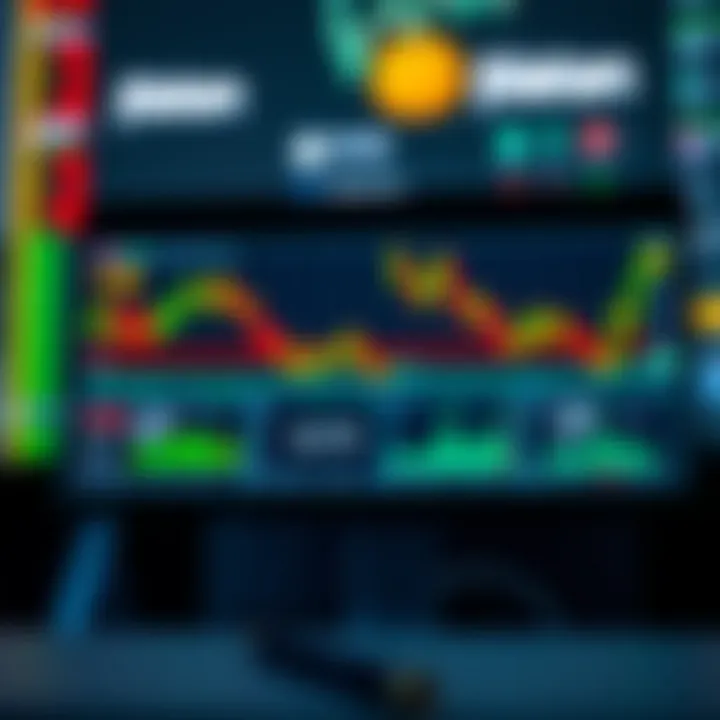Nasdaq Premarket Trades: Insights and Strategies


Intro
In the bustling world of finance, understanding the nuances of premarket trading on the Nasdaq can set a savvy investor apart. This segment of trading, often shrouded in mystery, operates before the main market opens and can present unique opportunities—and risks. For those who take the leap, becoming well-acquainted with the mechanisms, strategies, and implications of these early trades is a vital endeavor.
Premarket trading occurs between 4:00 AM and 9:30 AM ET, offering a window for investors to react to market-moving news without the noise that often accompanies regular trading hours. It's a bit like a secret garden where the few who venture in can find hidden treasures, but falling down the rabbit hole without proper guidance can lead to missteps and losses.
With this article, we aim to illuminate the intricacies of Nasdaq’s premarket environment. We'll explore current market insights, economic influences, investment strategies, and even some personal finance tips that can help you navigate these waters. This comprehensive analysis serves not merely as an academic guide but as a practical toolkit, preparing you to engage with the market intelligently and with confidence.
Intro to Nasdaq Premarket Trades
Nasdaq premarket trades represent a fascinating segment of the trading day, characterized by its unique dynamics and potential advantages for both seasoned investors and newcomers alike. Understanding this realm is crucial, as it opens doors to early insights about market trends and price movements before the official trading hours kick off. For traders, premarket trading can be akin to peeking behind the curtain, unveiling early reactions to overnight news, earnings reports, and other critical events that influence market sentiment. This can essentially level the playing field, allowing astute investors to make informed decisions ahead of the broader market.
Definition and Overview
Premarket trading refers to the buying and selling of stocks outside the regular trading hours of the stock exchange. For Nasdaq, the typical trading hours are from 9:30 AM to 4:00 PM Eastern Time, while premarket trading occurs from 4:00 AM to 9:30 AM ET. During this period, various market participants, including institutional investors and individual traders, can execute trades. The concept of premarket trading allows participants to react quickly to market-moving news, potentially capturing profits by making trades ahead of the standard market hours.
However, this segment comes with its own set of intricacies. The liquidity in premarket trading can vary significantly, often leading to larger spreads between buy and sell orders. This means that while you might spot an opportunity, the associated costs of trading can be higher compared to regular hours. Furthermore, the market may behave erratically due to lower trading volumes, making it crucial for investors to exercise caution.
Historical Context
The rise of premarket trading is closely tied to advancements in technology and the growing demand for 24-hour trading. Back in the day, trading was confined to the physical exchange floors, and accessing information took considerable time. With the implementation of electronic trading systems in the late 20th century, the landscape began to change. As these systems became more prevalent, they facilitated the creation of premarket sessions, allowing traders to act on news and developments as they occurred.
The significance of premarket trading has grown stronger over time, reflecting the evolving nature of global markets. During the dot-com bubble of the late 1990s, for example, premarket sessions gained traction as traders sought to respond to the rapid influx of technology stocks hitting the market. The nature of market competition has led to innovations that further enhance the capabilities of premarket trading, shaping it into an essential component of modern market dynamics.
As we delve deeper into the mechanisms and strategies associated with Nasdaq premarket trades, it is vital to understand these foundational elements. Not just because they inform trading decisions, but because they shape the broader context within which these trades occur.
The Mechanisms of Premarket Trading
Understanding the mechanisms underlying premarket trading is crucial for anyone looking to navigate this complex segment of the stock market. This area operates differently compared to standard trading hours, carrying distinct opportunities and challenges. By exploring the key elements, benefits, and considerations of this trading phase, traders can better position themselves for success.
Understanding Trading Hours
Premarket trading occurs before the official stock market opens, typically from 4:00 AM to 9:30 AM EST. During this timeframe, certain are available for trading, allowing investors to react to news and events that might influence stock prices. It’s vital to recognize that trading during these hours is conducted on a limited basis, often with lower volumes than during regular sessions. This can create a unique environment where stock prices may shift more dramatically in response to newfound information.
The early bird may catch the worm here; however, one must also be cautious, as the reduced liquidity can lead to significant price swings. In essence, knowing when to engage in this premarket phase can give savvy traders a first-mover advantage.
Order Types in Premarket Sessions
In the premarket window, traders primarily employ orders such as limit orders and market orders. Limit orders specify a price at which the trader is willing to buy or sell a security. In a low-volume setting, this can provide a clearer picture of the market. Market orders, on the other hand, execute immediately at the best available price but come with the risk of experiencing slippage.
The characteristics of these orders can significantly affect the trading outcome. Hence, knowing when to use each type can be vital for a trader’s strategy. For example, an investor might choose a limit order for executing trades on thinner volumes to maintain more control over entry prices, especially in a fluctuating market.
Role of Market Makers
Market makers serve a pivotal role in facilitating premarket trading. These financial institutions or individuals provide liquidity by being ready to buy and sell specific securities at specified prices. While they risk their own capital, their activity ensures that there’s always an opportunity to trade, even when markets are quiet.


Market makers help narrow bid-ask spreads in the premarket, thus leading to more efficient price discovery. Without them, there’d be fewer trading options available, causing more volatility. Some market makers might even set specific conditions based on their strategies, which can impact the investor’s ability to execute trades smoothly.
"Knowledge is power; understanding the mechanisms of trading can empower you in the premarket arena." - Unknown
Relevant Resources:
Strategies for Engaging in Premarket Trades
Engaging in premarket trades can be a game-changer for investors looking to gain an edge in the stock market. In this section, we will discuss the various strategies that traders can employ to navigate the complexities of premarket trading effectively. By understanding these strategies, investors can capitalize on opportunities that arise before the regular market opens, allowing for strategic positioning and potentially higher returns.
Analyzing Market Sentiment
One of the first steps in formulating a successful premarket trading strategy is analyzing market sentiment. Market sentiment refers to the overall attitude of traders towards a particular security or market in general. It can be influenced by various factors such as economic data releases, analyst ratings, or geopolitical events.
To gauge market sentiment, traders often rely on indicators such as the Fear and Greed Index or news aggregation platforms that compile sentiment indicators. Here are some key points to consider when analyzing market sentiment:
- Social Media Trends: Platforms like Twitter or Reddit can provide real-time insights into what retail investors are thinking about certain stocks, often swaying prices during premarket hours.
- Major News Headlines: Significant news stories can lead to immediate shifts in sentiment. For instance, a positive earnings report could boost investor confidence and spark buying interest before the bell.
- Economic Indicators: Data like employment numbers or inflation rates can set the tone for how stocks might perform before the traditional trading day.
Understanding market sentiment is like reading the room before a big meeting; it prepares you for how to respond and act strategically.
Technical Analysis Techniques
Technical analysis is a vital tool in the realm of premarket trading. Traders using this method review historical price movements and trading volumes to forecast future price action. Here are some commonly used technical analysis techniques pertinent to premarket trading:
- Chart Patterns: Familiarizing oneself with patterns like head and shoulders, flags, or triangles can offer insights into potential breakout scenarios.
- Moving Averages: Analyzing short-term moving averages can help identify the momentum of a stock during the premarket session. For example, if the stock price is trending above its 50-day moving average in premarket, it could indicate bullish sentiment.
- Volume Analysis: Watching the volume in premarket trading can signal the strength of a price move. A substantial volume spike can suggest that a stock is primed for action.
These technical indicators empower traders to make informed decisions and seize the right opportunity as the market begins its day.
Utilizing News and Event Indicators
Investors can significantly enhance their premarket trading strategy by keeping a close eye on news and events that could impact their stocks. Certain events can lead to drastic stock movements, making them crucial indicators for those trading in the premarket. Here’s how to work with news and event indicators effectively:
- Earnings Reports: Companies often release their earnings before the market opens. A positive or negative earnings surprise can lead to drastic price movements, making these releases key indicators to watch.
- Economic Reports: Government reports like GDP growth or consumer sentiment data can affect the wider market and individual stocks, influencing premarket activity.
- Sector-Specific News: Developments in specific sectors can prompt traders to react quickly. For instance, news affecting the tech sector can lead to a ripple effect in related stocks, necessitating swift action.
By aligning one's trading strategies with these news releases and event indicators, investors can make more insightful decisions in the premarket environment. Understanding how external factors can manipulate stock prices arms them with the knowledge to succeed in this often unpredictable trading window.
Risks Associated with Premarket Trading
Premarket trading may seem like a playground for savvy investors looking to capitalize on early-morning market movements. However, it comes with its own unique set of risks that are worth exploring. Understanding these risks is essential for anyone looking to navigate the premarket waters wisely.
Liquidity Challenges
One of the primary concerns during premarket trading is liquidity. This refers to how easily assets can be bought or sold without affecting their price. In the premarket, trading volumes can be significantly lower than those seen during regular hours. For instance, a stock that normally trades thousands of shares may only see a handful during these early sessions. This reduced liquidity can lead to wide bid-ask spreads, making it more difficult to execute trades at desired prices.
Investors often find themselves in a jam when trying to sell their positions due to the lack of available buyers, or conversely, when trying to buy, they may face inflated prices due to scarcity.


Points to Consider:
- Order execution: Delays may occur.
- Price impact: A single transaction could significantly sway stock prices.
- Increased slippage: Costs can rise due to low liquidity.
Volatility Considerations
The premarket sessions can exhibit significant volatility, often spurred by economic news or corporate announcements that happen outside regular trading hours. Stocks can jump or plummet wildly based on these developments, which sometimes don’t appear as significantly in regular trading hours. This heightened volatility is a double-edged sword; it offers opportunities, but it also ramps up the risk of substantial losses.
For example, if a company announces an earnings miss before the market officially opens, traders may respond by rapidly selling off shares, creating a steep decline in price. Investors must ask themselves: Are they equipped to handle sudden price swings?
Key Considerations:
- Stop-loss orders: May not be effective due to rapid price changes.
- Emotional trading: Fear and euphoria can cloud judgment.
- Event-driven risk: Major announcements can lead to unpredictable stock movements.
Regulatory Aspects
When venturing into the world of premarket trading, understanding regulatory parameters can also impact trading strategies. Premarket trading is subject to different regulations than regular hours, which are set to ensure fair practices and investor protection. Limited trading options, for instance, might create confusion among traders. If you're unaware of these regulations, you might find yourself inadvertently violating trading laws.
Furthermore, some stocks may not be eligible for premarket trade due to their classification or current status, leading to missed opportunities for traders who are uninformed. Regulatory bodies like the Securities and Exchange Commission (SEC) aim to protect investors, but it's up to individual traders to stay informed. Therefore, it’s prudent to regularly consult resources such as SEC.gov to ensure compliance and to understand the latest rules affecting premarket trading.
Things to Remember:
- Know your trading venue: Different platforms have different premarket regulations.
- Stay updated on news: Regulatory changes can come without much prior notice.
- Consult professional advice: When in doubt, seeking guidance can help steer clear of regulatory pitfalls.
Impact of Premarket Trades on Regular Trading Hours
Premarket trading plays a fundamental role in shaping the price movements and overall market dynamics once regular trading hours commence. This section sheds light on the implications that premarket activity can have during the day when major trading occurs, underscoring its importance for both investors and market analysts alike.
Price Movements and Corrections
The correlation between premarket trades and price movements during regular trading hours cannot be overstated. When significant trades occur before the market opens, this can lead to considerable adjustments once trading resumes. Investors keeping an eagle eye on these movements may notice that often, the prices in the premarket reflect a consensus of sentiment influenced by news, earnings reports, or macroeconomic factors.
For instance, if a tech company releases earnings that exceed analyst expectations during the premarket, shares may jump upward significantly before most investors have a chance to participate. This change could lead to a gap up once regular trading begins, meaning that traders who enter the market without acknowledging premarket trends may find themselves out of the loop, purchasing at a higher price than desired.
In addition, it’s not uncommon for stocks to experience price corrections, where the initial spike could settle down quickly, resulting in decreased prices throughout the regular session. Market psychology plays a big factor here where traders readjust their positions based on premarket activities. For those in the know, capitalizing on these movements requires constant attention to premarket trading data.
“Understanding premarket dynamics can position an investor advantageously when regular trading opens, as gaps frequently occur due to overnight news impact.”
Considerations:
- Volatility: Premarket trading can reveal how investors are reacting to overnight news, leading to increased volatility.
- Market Gaps: Significant price movements often create gaps which might not always correct immediately.
- Informed Decisions: Investors equipped with knowledge of premarket trends can make more informed trading decisions during regular hours.
Influence on Market Sentiment
The premarket session serves as an important indicator of overall market sentiment. Trades executed in this segment are often driven by fresh news, announcements, or external factors affecting particular stocks or sectors. The prevailing attitude towards the stock market can be assessed by observing patterns in premarket trading.


If traders show strong buying interest before the market opens, it’s likely these sentiments will carry into the regular session. Conversely, a notable downtrend in premarket might hint at upcoming challenges during the day ahead. This sentiment can create expectations that impact the decisions traders make — essentially setting a mood that can effect stock prices.
Investors who analyze premarket trading can gauge whether the market is tilting towards a risk-on or risk-off approach.
Key Points:
- Predictive Power: Observing premarket trades can provide clues about the direction of stocks during regular hours.
- Sentiment Shift: A quick pivot in premarket activity may suggest an impending change in market sentiment.
- Opportunity: Traders can adjust their strategies based on perceived sentiment shifts revealed during the premarket activity.
The impact of premarket trades on regular trading hours is significant and multifaceted. Not only do these trades predict potential price movements and corrections, but they also establish an atmosphere of market sentiment that traders must navigate effectively.
Case Studies: Premarket Trading Examples
Examining case studies in premarket trading provides a crucial lens through which investors can understand how to navigate the often choppy waters of early market activity. These real-life scenarios can highlight the unpredictability of the market and showcase both pitfalls and opportunities. By analyzing past movements, traders can draw valuable lessons, refining their strategies to bolster their chances of success. This section will delve into significant premarket movements and successful trading scenarios, offering insights into the mechanics of premarket trading and its implications.
Notable Premarket Movements
Premarket trading can often serve as the proverbial canary in the coal mine, alerting traders to potential market trends even before the regular hours. For instance, the January 2021 surge of shares for GameStop, which was driven by retail investors, showcased how sentiment circulating on social media platforms could lead to explosive moves in the premarket. This phenomenon wasn't just a one-off; numerous stocks saw similar reactions, fueled by discussions in various online forums, exemplifying the new reality that information exchanges today happen at lightning speed.
The significance of such movements lies not only in the immediate profit potential but also in the broader implications for market behavior. When a stock experiences a striking shift, such as the rapid rise seen in Amazon shares ahead of positive earnings reports, it can alter the overall market sentiment. Investors who are attuned to these early indicators can position themselves advantageously, either capitalizing on the movement or hedging against volatility that might ripple into regular trading hours.
“In premarket, even slight movements can forecast larger trends. Staying alert is key.”
But it’s not just about observing the trends — understanding the drivers behind these movements is equally essential. Factors such as economic reports, geopolitical tensions, or earnings surprises can all contribute to noteworthy premarket trading activity. Examining how these factors have historically impacted specific stocks can prepare investors for similar future scenarios.
Successful Trading Scenarios
Now, let’s peel back the layer on successful trading scenarios in the premarket landscape. One vivid example comes from the tech giant Apple in October 2020. Following a superior earnings report, shares surged in premarket due to optimistic forecasts and higher-than-expected product sales. Investors who acted decisively in the premarket witnessed impressive returns, as the stock continued its upward trajectory during regular hours.
An effective strategy that traders employed in this instance revolved around news analytics and quickly validating the claims made by the company. By scrutinizing financial statements and accompanying forecasts, savvy investors could ascertain the authenticity of the numbers before the market truly reflected them.
Another successful scenario is illustrated by how many traders engage in risk management during earnings announcements. For example, during key earnings calls, opportunistic trading is often initiated in the premarket, allowing traders to place bets on expected volatility. Those who prepared and developed specific strategies tailored to their risk tolerance often saw success without having to endure the wild swings common during regular trading hours.
In summary, examining case studies of premarket trading reinforces the realities of market behavior, emphasizing the need for a keen eye and a readiness to act. Identifying notable movements and successful trading strategies is critical for investors looking to harness premarket activity effectively.
Epilogue and Future Perspectives
In wrapping up our examination of Nasdaq premarket trades, it becomes clear that this niche segment of the trading world is anything but trivial. With an understanding of how premarket trading operates, traders can position themselves favorably against the market winds before the regular trading hours commence. Investment decisions made during these hours are not merely based on instinct or luck; they rely on a calculated comprehension of market psychology, trends, and strategic approaches.
Summarizing Key Insights
A few key insights can be distilled from our exploration of the premarket realm:
- Market Impact: Premarket trades significantly influence the day’s market trajectory, creating a ripple effect that can affect investor sentiment and stock valuations.
- Strategic Advantage: Access to this period allows traders to leverage news updates and announcements which can dramatically shift stocks before the bulk of traders even takes their positions.
- Risks and Opportunities: While liquidity can be less, the potential for gains during this timeframe is juxtaposed with the risks inherent in volatility.
- Technological Edge: Integrating advanced trading tools and market analysis can enhance decision-making and profit prospects during unpredictable premarket phases.
These insights not only provide clarity but also serve as a foundation for traders to develop their own approaches and refine their strategies moving forward.
Future of Premarket Trading
Looking ahead, the future of premarket trading is likely to be shaped by several key trends:
- Technology Integration: As technology evolves, algorithmic trading platforms will further penetrate this market, allowing for sophisticated trading strategies that operate in real-time.
- Regulatory Changes: The SEC continually evolves its regulations, impacting trading hours and procedures. Staying abreast of these developments will be essential for traders.
- Increased Access: A growing number of retail investors are entering the market, leading to heightened volatility and opportunity during premarket trading sessions.
- Expanded Data Use: Enhanced access to data analytics and sentiment analysis tools may provide traders with deeper insights into potential market shifts even before they occur.
Investor education and adaptability within this growing framework will be paramount. As we step into a new era of trading, understanding the intricacies and future trends in premarket activity will empower investors. The advantages are immense, yet one must navigate through the risks wisely. The premarket landscape is not merely a preview of the day’s trading but a burgeoning arena waiting for the savvy trader to capitalize on its latent potential.



